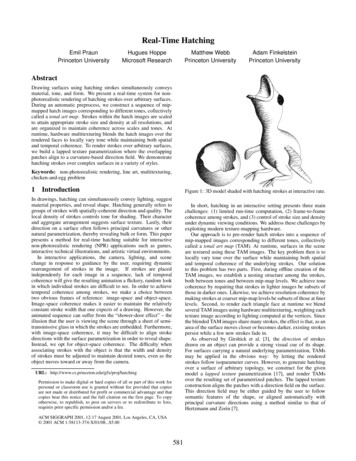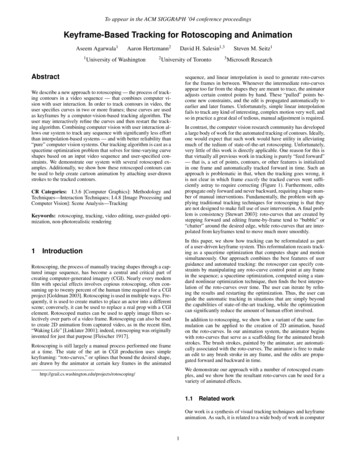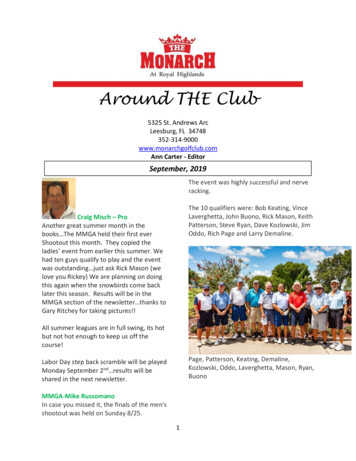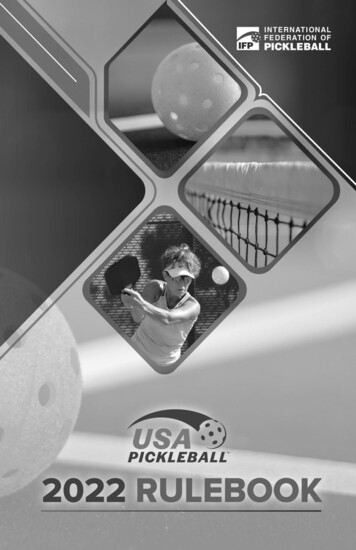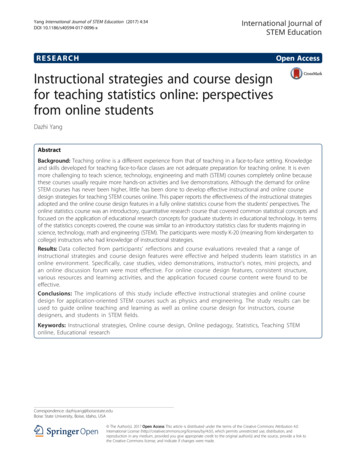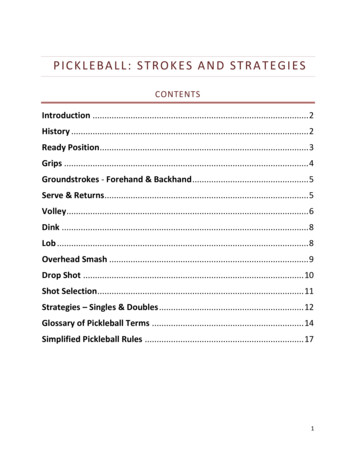
Transcription
PICKLEBALL: STROKES AND STRATEGIESCONTENTSIntroduction . 2History . 2Ready Position . 3Grips . 4Groundstrokes - Forehand & Backhand . 5Serve & Returns. 5Volley . 6Dink . 8Lob . 8Overhead Smash . 9Drop Shot . 10Shot Selection. 11Strategies – Singles & Doubles . 12Glossary of Pickleball Terms . 14Simplified Pickleball Rules . 171
INTRODUCTIONPickleball is a fun, fast-paced sport that is gaining popularity around theworld. Pickleball combines elements of tennis, badminton and table tennis. Itis an easy to learn sport that can be played either indoors or outdoors. It candevelop into a fast paced competitive sport. In addition the sport hasdeveloped a passionate following due to its friendly social nature and itsmulti-generation appeal.It is played on a badminton size court with a seamless perforated plasticball (whiffle ball, baseball size). It is hit with a solid smooth paddle either afterone bounce or in the air (volley). The object of the sport is to hit the ball overthe net which is approximately 3 feet high to the opponent(s) in such a waythat it cannot be returned successfully. While singles and doubles are bothplayed, doubles is currently more popular.The spread of the sport is attributed to its popularity within schools,community centers, YMCA facilities, clubs and retirements communities.Learn a new lifetime sport. Let’s play pickleball.HISTORYThe game of pickleball began in the summer of 1965 on BainbridgeIsland, Washington, by Joel Pritchard and Bill Bell as a means of entertainingtheir families. An old outdoor badminton court provided a place to play.All kinds of equipment was used and modified in pickleballs beginning.They created simple rules, staying true to the original goal of creating a gamethat the whole family could play together. They began with the rules ofbadminton, changing them to deal with the alterations they’d made.Accounts of how the name Pickleball originate vary. Popular belief asrelated over the years is that the game was named after the dog “pickles.”Pickles would hide in the bushes and chase down errant balls. As soon as theball came his way, he’d dash out grab the ball and run away.2
As more people played the game. The need for consistent rules andequipment standards became more important. The USAPA (United States ofAmerica Pickleball Association) was organized in 1984 to oversee the sport.They are the national governing body of the sport.Now pickleball is played as a competitive sport around the world. Newpickleball courts are being built every day. Today it is estimated that over 2million people play pickleball, with an estimated 8 million players by 2018.From elementary school children to the senior market the sport is exploding.Get on the bandwagon and stay fit for life while having fun. PLAYPICKLEBALL.READY POSITIONThe key to your ability to play Pickleball with any degree of success is tobegin in a good ready position. It is a position from which a player is ready tomove quickly forward, back, side to side and diagonally forward and back. It isa dynamic, not a static position, with the players constantly alert and preparedto move quickly in any direction.KEY POINTS TO REMEMBER1.2.3.4.5.6.7.8.Maintain a base with your feet about shoulder width apartKnees are slightly bentWeight is on the balls of the feetFocus on the ball on the other side of the netHand holds paddle chest high in front of the bodyHold the paddle firm but not tightBe relaxed and ready to reactEyes are tracking the ball3
GRIPS#1 Eastern Backhand#2 Continental#3 Eastern Forehand12Paddlehandle3#4 Semi-western4What grip you hit with is extremely important. Grips influence the angleof your paddle face (flat, open, closed). A good grip is an essential part of agood pickleball stroke. Grips can be confusing “eastern, western, continental,semi-western”. Let’s take a look at the different grips and there effect on theracquet angle, thus the flight of the ball.The grip should be held firm not tight. For the forehand grip, hold thepaddle in your dominant hand with the head of the paddle perpendicular tothe ground and the handle facing you.Shake hands with the paddle, wrapping your fingers around the gripwith the base knuckle of your index finger aligned with the #3 position(eastern forehand) above.Some players adjust the grip on the paddle for hitting a backhand shot,others do not. It is a matter of personal preference. To change your grip for abackhand shot, turn your hand to the left or counterclockwise (for a righthanded player) so the base knuckle is now on the #1 position ( easternbackhand) above. This will flatten the paddle head out. For those people whouse one grip, the #2 position (continental) above is where you want toposition your knuckle of your index finger. For more aggressive top spin trythe #4 position (semi western) aboveGood players will change their grip depending on the kind of shot theyare going to take. Most important when determining the best grip to use is toselect one that is comfortable and allows for good control of the paddle.4
GROUNDSTROKES - FOREHAND & BACKHANDThe forehand and backhand groundstrokes are the basic strokes usedwhenever a player returns a ball from a position of midcourt to deep in thecourt. A forehand is from the same side of your body as your dominant hand,and a backhand is hit from the opposite side.The successes of your groundstrokes are directly related to your abilityto move in all directions on the court quickly and smoothly. From the momentthe ball leaves the opponents paddle, you should be tracking its flight to aidyou in judging the speed and direction of the ball.KEY POINTS TO REMEMBER1.2.3.4.5.6.7.8.9.10.11.The key to a well-executed stroke is early preparationAlways start from a ready positionMove the paddle back in anticipation of the groundstrokeEPP –early paddle preparationTurn your shoulders and hips toward the sidelineContinue the backswing of the paddle until it is pointing directlyat the back fence or wallShift your weight from your rear foot to your front footThe knees are flexed for balanceFollow through by allowing your swinging arm to continuethrough toward the target.Your head, eyes, hips and shoulders face the netPractice taking the paddle back high, low and waist high at slow,moderate and fast speedsSERVE & RETURNSThe serve puts the ball in play; therefore it could be considered the mostimportant skill in the game. You need to be able to hit the ball legally from aposition behind your baseline over the net into your opponent’s service court,which is diagonally opposite you.5
Perhaps the second most important skill to master is the return of serve.Keep those returns in play and don’t commit any unforced errors. Don’t beatyourself. Remember hit your serve and return of serve smarter not harder.Refer to the simplified rules of serving and the faults for more details.KEY POINTS TO REMEMBER1.2.3.4.5.6.7.8.9.10.11.A legal serve is hit with an underhand motion, not side arm oroverhead. Contact must be made below the waistThe ball must be contacted before it hits the groundThe ball must clear the net and land in your opponent’s courtdiagonally opposite the serverBoth of the servers feet must be behind the baselineIf any part of the ball contacts the non-volley zone line or entersthe zone it is a fault and you lose your serveAll other lines are considered goodEach side must make one groundstroke before the ball can bevolleyedServes can be hard driven low over the net or slow-moving highlobs and half lobsAll serves should be deep in the backcourt or just dropped in overthe non-volley zone line.The key to serving is consistency and varying the height, speed,angle and depth of the serve.Don’t try to ace the service return. Accuracy is more importantthan a power return. Return the ball deep in the courtVOLLEYA volley is a shot hit in the air before the ball bounces. It is used asa return of a ball that travels with force usually close to the top of the net. It isexecuted from a position just behind the non-volley zone, and it can beoffensive or defensive in nature. A volley is offensive when the flight of theball that you hit is downward, allowing you to put more force on the ball. A6
volley is defensive if you make contact with the ball below the height of thenet. The ball you hit is traveling upward (open face) giving your opponentsthe opportunity for an aggressive return.There are a variety of volleys each with different types of spin andpaddle angles. The physics of spin on a ball means that topspin, backspin(chop/slice), and a flat shot will travel very differently. A flat volley willbounce higher than a backspin volley, while not as high as a topspin swingingvolley. If your opponent hits a topspin swinging volley the ball will drop downfaster causing it to bounce higher. By contrast, a backspin slice volley willbounce lower. See the glossary of terms for the different types of volleys.The closer you get to the non-volley zone line the more angles youhave at your disposal. Think smarter not harder. Volleys are usually made atthe net. Your entire demeanor at the net should be confident and strong. Youshould be in the ready position focused on the ball to make solid contact.KEY POINTS TO REMEMBER1.2.3.4.5.6.7.8.9.10.11.Ready position, face the net, flexed knees, balancedKeep the paddle chest high between you and the netKeep backswing and follow through shortGo to the ball – keep the action in front of youBe patient – don’t rush your shotBe light on your feet – ready to attackGrip the paddle firmly – not tightlyAdjust the paddle angle. If the ball is coming in to you high,slightly close the face of the paddle. If the ball is closer to the topof the net, square the face up. If the ball drops below the net youwill have to open the paddle face and bend your knees to make agood shot.Keep your arm movements short , quick and from the shoulderTry to place the volley down the middleKeep your movements simple and controlled7
DINKTo be a good pickleball player you must learn and perfect several skills,none more important than the dink shot. A dink is a soft shot, made with theface of the paddle open, and hit so that it just clears the net and drops into thenon-volley zone. It is hit after the ball bounces. Remember you can step intothe non-volley zone any time except when you are hitting a volley. After theball bounces you can go all the way to the net to hit the ball, providing you donot touch the net with any part of your body, clothing or paddle. Your entiresoft net game depends on your ability to execute consecutive dink shots withsuccess.KEY POINTS TO REMEMBER1. Stand just behind the non-volley zone in a good ready position2. Hold the paddle in front of your chest3. The head of the paddle is perpendicular to the ground. This allows aquick smooth movement to either side4. Move to the ball using short quick steps5. Bend low and keep your balance6. Reach for the ball with an open paddle face7. Step forward with your right foot (for a righty)8. Contact the ball low to the ground with a lifting action9. Dinking can continue for quite a long time. Don’t be impatient. Thedink requires a soft, delicate touchLOBThis shot is used when you need to drive your opponent away from thenet and back to the baseline (offensive lob) or when you need time to recoverfrom a shot that has forced you out of position (defensive lob). The lob shouldtravel over your opponents head and land just inside the baseline. A wellexecuted lob requires a feel for knowing how hard to hit the ball and howmuch loft to apply. Think of it as being a soft lift of the ball, not a brisk hit.8
KEY POINTS TO REMEMBER1. When executing a lob, approach the ball as if you were going to hit agroundstroke from the ready position2. Hit with an open paddle face, less power and a higher follow through3. Keep your head steady and your eyes on the ball4. Swing the paddle arm forward and contact the ball with a liftingmotion5. Shift your weight from your rear foot to your forward foot6. Follow through quite high, with your paddle following the trajectoryof the ball7. Hit with enough loft over opponents outstretched arms and paddle8. The more deceptive you are as you execute the offensive lob, themore effective it will be9. Hit a defensive lob as high in the air as possibleOVERHEAD SMASHThe overhead smash is the most aggressive offensive shot inpickleball. The smash is a forceful hit executed as high in the air as the playercan reach and directed downward at a sharp angle into your opponent’s court.A well-executed smash is almost impossible to defend.The overhead smash is used as a return of a high lofted ball hit bythe opponents. It’s important to keep the paddle angle closed, with the top ofthe paddle angled downward. If you don’t close the face, this shot will mostlikely travel too high and head out of bounds. Don’t close the face too much,however, as this will put the ball into the net.The closer you are to the non-volley zone line the sharper thedownward angle you can put on your smash. The smash can only be executedwith high balls, either from a bounce or volley, or with lobs, especially thosethat aren’t executed well and fall short.9
KEY POINTS TO REMEMBER1. Move to a position behind the ball2. Track the flight of the ball with your eyes. As you move into positionturn sideways and point your non paddle hand at the ball3. Bring the paddle up behind your head (answer the phone)4. Swing the paddle arm up and forward so that you contact the ballhigh in the air (high five the giant)5. Shift your body weight from the rear foot to the forward foot6. After ball contact follow through letting your arm continue in adownward arc across your body and toward the ground ( put thesword away)7. Know where you are on the court at all timesDROP SHOTA drop shot is a very important shot because many players feel itshould be used almost automatically as the third shot in every doubles game.A typical rally in a well-played pickleball game will include the first shot of aserve that lands deep in the court diagonally across from the server; thesecond shot of a return of serve that is high and deep giving the serve receivertime to get to the non-volley zone line to join his partner; and the third shot ofa drop shot hit by a player on the serving team. That shot then, is followed upwith both partners hustling to the non-volley zone line.A drop shot is hit off a bounce from deep in the court. While thebody position of the player hitting the drop shot resembles that of a playerhitting a ground stroke, the forward swing of the paddle arm is slower. Theobject of hitting a drop shot is to give the team deep in their court (usually theserving team) the opportunity to follow up the shot to the non-volley zoneline. You don’t want to angle the ball too high or your opponents will smash itback at you; don’t send the shot too low or the ball won’t make it over the net.When hit correctly, the ball will just drop over the net and land in theopponents non-volley zone.10
KEY POINTS TO REMEMBER1. Move like you are hitting a groundstroke2. As you take the paddle back, open the face of the paddle slightly3. As you move forward with your paddle arm, focus on a soft,controlled contact with the ball4. Your weight should shift from your rear foot to the forward foot5. After contact, follow through toward your target6. The flight of the ball should be somewhat lofted7. Most important when executing a drop shot is that it be soft andcontrolledSHOT SELECTIONAs in any other racquet or paddle sport that includes a net, a gameof pickleball involves players’ selecting a type of shot based on the type anddirection of the hit coming to them from the other side of the net. There is aninitial pattern or sequence of shots that produce exciting exchanges betweenteams. You must become familiar with the sequence. You must practice eachshot in the total game over and over until you are confident that, when calledon to use that shot you can execute it with good control.The following sequence of shots is ideal because it provides ameans for all four players to get to the net. Rallies are won and points arescored from the net, not from the baseline or midcourt (no man’s land). Firstwork on serving the ball deep 100 percent of the time. Then return the serveslow, deep, and down the middle. Finally make the third shot, which ideally isthe drop shot. The third shot will determine whether the serving team can getto the net and consequently has a chance at winning the rally. If you haven’tmastered the drop shot, hit a groundstroke down the middle or down theright sideline as a passing shot or hit a lob. You have to put the serve receiveteam on the defense to enable you and your partner to get to the net. Masterthe four shot sequence below.11
FIRST SHOT – SERVE1. Serve the ball deep, into the proper court2. After the serve you and your partner stay backSECOND SHOT – RETURN OF SERVE1. Hit a return that is down the middle slow and deep2. Hitting it slow gives you time to follow up your shot to the non-volleyzone line so you are side by side with your partnerTHIRD SHOT – DROP SHOT, GROUNDSTROKE, LOB1. A drop shot that you and your partner follows up to the non-volleyzone line2. A hard groundstroke down the middle causes confusion3. A lob that forces the serve receive team deepFOURTH SHOT – DEPENDS ON THIRD SHOT1. If the third shot is a drop shot, the fourth shot most likely will be adink return. All four players are now at the non-volley zone line anddink back and forth2. If the third shot is a groundstroke down the middle, the fourth shotwould most likely be a volley3. If the third shot is a lob, the fourth shot would most likely be either agroundstroke or another lob off the bounceOnce all four players are at the net, what happens is dependent onwhich player commits the first error.STRATEGIES – SINGLES & DOUBLESAs you learn and perfect the skills of pickleball and play morecompetitive games, you begin to realize that there’s more to it than hitting theball back and forth across the net. Pickleball players vary in terms of their12
objectives for playing the game – from the recreational player whose goal is toget exercise in a fun way to the competitive tournament player. The processof learning the game and then being able to play as well as you can is thesame. You must be able to control the ball coming off your paddle, and youmust be able to execute each skill and know when to use it in a game situation.Then you can start thinking about strategy.Not enough can be said about keeping the ball in play. Give youropponents an opportunity to beat themselves. Three out of four rallies arewon or lost because of errors. Below are some suggestions for your doublesstrategy.1.2.3.4.5.6.7.8.9.10.11.Strive for 100 percent accuracy on servesDon’t let anything down the middle. The forehand player has theprimary responsibility for balls down the middleCommunicate, communicate, and communicateAnticipate what the return shot will be and move into a positionto cover the angle of the return shotMove up to and back from the net together as a teamMove left and right together, both at the baseline and at the netAlways know where you are on the court and where the boundarylines areOnce you are at the kitchen, stay thereAlways strive for placement and control rather than speed whenyou hit the ballUnforced errors happen. Forget it and move onHave fun! Pickleball is the best. Enjoy being on the court, beingsocial, and getting exercise all at once. There are definitely worseplaces you can be than on a pickleball court, so while you arethere, get your game on and have fun!Singles play is much more demanding physically. The obvious differencebetween singles and doubles is that only one player is competing against oneopposing player in a singles game. When the servers score is even, he servesfrom behind the right service court, when his score is odd, he serves from13
behind the left service court. The skills are the same, although in singles softshots at the net (dinks) are not as prevalent as in doubles. The server standsright next to the center line so that he can easily move either to the right orleft to get to the return shot. Playing pickleball singles requires a player notonly to be in good physical condition but also to be able to anticipate the nextshot from the opponent. There’s no partner to help cover the court.In any game, you must be able to execute the required skills with somedegree of consistency before you can hope to use strategy effectively duringcompetition.GLOSSARY OF PICKLEBALL TERMSAceA serve that is not returned by the opponent.Approach ShotAny shot which allows you to approach the net. A forehandor backhand that is driven deep in your opponent’s court.BackcourtThe area of the court within a few feet of the baseline.BackspinSpin imparted to the ball by stroking it from high to low,causing it to spin back to the net once it bounces.BaselineThe back line of the court (22 feet from the net).CenterlineThe line bisecting the service court that extends from thenon-volley zone line to the baseline.Cross-CourtThe opponents court diagonally opposite yours.Dink ShotA soft shot that is intended to arc over the net and landwithin the non-volley zone.Double BounceRuleAfter a serve, each team must play their first shot off thebounce, after which the ball can be played off the bounce orvolleyed.DoublesA game played with teams of 2 players on each side of thenet.14
Drive ShotA powerful stroke hit low and fast.Down the LineA shot hit near a sideline that travels close and parallel tothe same line.Drop ShotA soft shot, usually initiated from mid to back-court, thatarcs just over the net and lands within the opponent’s nonvolley zone. This allows you and your partner to get to thenet.Drop VolleyA soft volley that is designed to slow the speed of the balland return it short, just over the net. This shot is especiallyeffective when initiated close to the non-volley line.FaultA fault is any action that stops play because of a ruleviolation.FollowThroughA continuation of the motion of your swing that follows thedirection you wish the ball to travel.GroundstrokesHitting the ball after one bounce. Forehand Stroke, madefrom the same side of your body as the hand holding thepaddle. Backhand Stroke, made from the side of the bodyopposite from the hand holding the paddle. Half Volley, is agroundstroke made just after the ball has bounced. Usuallyhit just a few inches from the ground.Half VolleyA groundstroke in which the paddle contacts the ball after itbounces but before it rises to its potential height. Usually hitjust a few inches from the groundKitchenAn affectionate name for the non-volley zone.LetA serve that touches the top of the net and lands in theproper service court (it is replayed without penalty). A letmay also refer to rally that must be replayed.Lob ShotA very high and soft shot that is intended to land near thebaseline. It forces the opponent back to the baseline.15
MidcourtThe area between the non-volley zone and the backcourt.Non-VolleyZoneA seven-foot area adjacent to the net within which you maynot volley the ball.Overhead ShotA shot made with the paddle over head height. Oftensynonymous with a smash or slam. Usually resulting froman opponent’s lob, high return, or high bounce.Passing ShotA shot that gets by the reach of your opponentPlacementVolleyHitting the ball while it is in the air, before it bounces. Thisshot is placed beyond the reach of the player and landsinbounds.PoachIn doubles, to cross over into your partner’s area to play aball. An aggressive shot that puts a lot of pressure on youropponents.RallyHitting the ball back and forth between opponents.Serve/ServiceAn underhand lob or drive stroke used to put a ball intoplay at the beginning of a point.Server NumberWhen playing doubles, either “1” or “2,” depending onwhether you are the first or second server for your side.SliceAnother name for backspin or underspin. Hitting thebottom half of the ball with a chopping motion (High toLow).SpinWhen you hit the ball off center the ball will spin.SwingingPower VolleyA ball hit out of the air with an aggressive swing usually hitwith topspin for a winner.TopspinSpin applied to the ball by stroking it from low to high.USAPAUnited States of America Pickleball Association. Thenational governing body of pickleball in the USA.VolleyHitting the ball in the air, during a rally, before the ball has a16
chance to bounce onto the court.SIMPLIFIED PICKLEBALL RULESA complete set of rules may be obtained from the United States ofAmerica Pickleball Association on their web site (www.usapa.org).GAME AND MATCHIn tournaments, a match will usually consist of the best 2 out of 3 gamesto 11. A game is over when one player or team reaches 11 points and isleading by at least two points. If the score is tied at 10-10, then the gamecontinues until one player or team wins by two points. Players switch sidesafter the first game. If a third game is needed, the players will switch sidesafter the first player or team gets to 6 points, and the game will then continueto its conclusion.SERVINGIn Pickleball a player or team can only score points when serving Players must announce the score prior to serving. Always call theserver's score first!The serve must be made with an underhand stroke so that contact withthe ball is made below waist level.Underhand Defined: The arm must be moving in an upward arc andthe paddle head shall be below the wrist when it strikes the ball. Bothfeet must remain behind the baseline, and at least one of your feet mustbe in contact with the ground when the paddle contacts the ball. Youmust also serve from within the confines of the serving area. Theseconfines lie behind the serving court baseline and on or behindimaginary lines that extend from the court centerline and sideline.Serves must land in the diagonal backcourt behind the opponent’s nonvolley zone line. Each player is allowed only one serving attempt unlessit is a “let” serve. A let serve occurs when the serve hits the net and still17
lands in the correct service court. If this occurs, the serve is played over.Each player will continue to serve until he does not win a point.SERVING IN DOUBLES At the start of each new game, only one player on the first servingteam is allowed a service turn before giving up the ball to theopponents. Thereafter both members of each team will have a serviceturn before the ball is turned over to the opposing team.In doubles, the player on the right at the start of a service turn, will bethe first person to serve for their team and will continue to serve untilhe or she does not win a point. Then his or her partner will serve untilhe or she also does not win a point. Then it is the other team's turn toserve.When the serving team scores a point, the server moves to the otherside of the serving team’s court. The receiving team should never switchsides.If the serve rotation is done properly in doubles, the serving team'sscore will always be even when the player that started the game on theright side is on the right side and odd when that player is on the leftside. In doubles the player in the right-handed court always startsservice for the team.SERVING IN SINGLES In singles, the server will serve from the right when he has an evennumber of points (0, 2, 6, 10). The server should serve from the leftwhen he has an odd number of points (1, 3, 7, 9). The receiver shouldadjust their position according to where the server stands.NON-VOLLEY ZONE (THE KITCHEN)To volley a ball means to hit it in the air without letting it bounce. Allvolleying must be done with the player’s feet behind the non-volley zone. Youmay step or stand in the non-volley zone at any time, but if your feet are in thezone, you must play the ball off the bounce. It is not a fault if your paddlemoves in the air over the non-volley zone.18
If a player's momentum causes them to step on or over the non-volleyline after hitting a volley they have committed a fault.If a player's paddle, clothing, hat, or any part of their body touches anypart of the non-volley zone while hitting a volley or because of theirforward momentum after hitting the ball it is a fault.A player may jump across the no-volley line after hitting a volley if theydon't touch any part of the non-volley zone including the lines whiledoing so.DOUBLE BOUNCE RULEEach team must play their first shot off the bounce. That is, the receivingteam must let the serve bounce and the serving team must let the return of theserve bounce before playing it. After the two bounces have oc
a return of a ball that travels with force usually close to the top of the net. It is executed from a position just behind the non-volley zone, and it can be offensive or defensive in nature. A volley is offensive when the fligh
